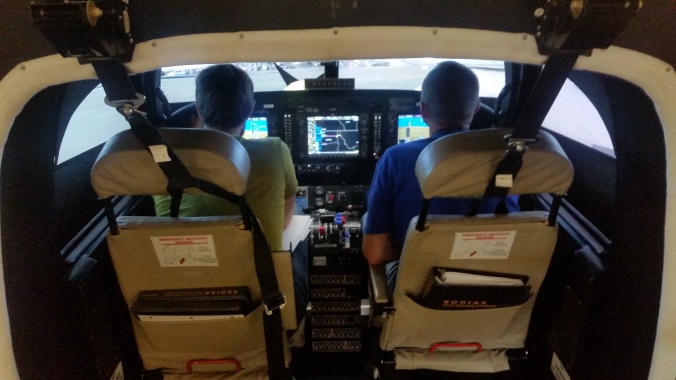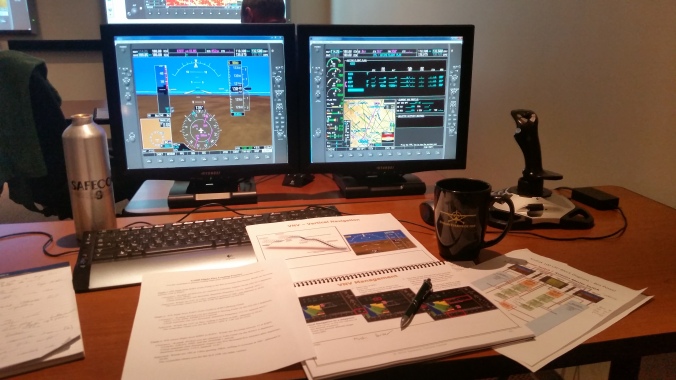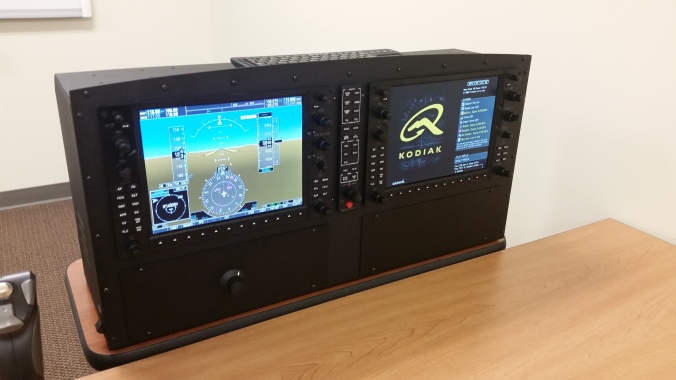I am trying not to let a looming cold encumber me. I held on all morning as we discussed KODIAK performance limitations, hoping no one would notice my soggy nose and screeching throat. Precise numbers are tough to remember as they relate to certain aircraft and engine speeds, but I have solid grasps of the concepts behind the data.
As the afternoon progressed, my mind increasingly dragged as we moved into studying the G1000 avionics system. Yesterday this info was new but familiar, so I expected another straightforward day of learning.
Wrong!

This is the interior of our Quest KODIAK simulator, which is pretty much identical to the airplane. Remember all of the round gauges that used to be in airplanes? Those are mostly gone now. The KODIAK has a digital aviation electronics system called the G1000. It has three screens, lots of knobs, buttons, and awesome capabilities… if you know how to use it.
With some post-lunch coffee I was initially okay, but then we got into flight planning, and I was lost. Airplanes simply didn’t do all of this electronic stuff when I learned how to fly them! Can I really be the old geezer wagging his finger at the young instructor, saying “you kids with your new-fangled computers just don’t know what it’s like to fly with analog instruments only!”
Part of my frustration was relates our training tools. Remember me mentioning Parkwater Aviation, the subsidiary organization of Spokane Turbine Center? Last winter, Parkwater was able to buy two snazzy G1000 desktop trainers that are functionally identical to the airplane displays, with all the buttons and knobs you’d find in the real airborne system. Each desktop training is worth a cool $12,000 delivered.

This was my seat in class today. Note the coffee, pages of notes, and the frustrating combination of mouse/joystick. I could not press the buttons and turn the knobs myself; I had to manipulate a mouse that had a different perception of reality.
I’m so thankful that the real missionary pilots in our class have these units to use. An older desktop-computer based training system site before me. Instead of pressing buttons and turning knobs, I’m stuck using a joystick and mouse to mimic the dance of my fingers over the real system. It just isn’t the same. I know what knob I wish to “twist”, but the computer and I disagree on precisely where the mouse needs to be to activate certain functions.
As Pauline instructed her heart out, my non-American classmates both followed along. But I was lost. I’ll spare you boring technical details here, but I knew more about the fate of Amelia Earhart than how to select what I needed to ‘on-ramp’ entry points for a VOR. As my classmates easily figured out each item, I was still trying to figure out how to turn the LARGE knob, not the SMALL knob from two menus ago. Come on, computer!!
I told Pauline to keep going. Don’t wait for slow, old me.
One of the many benefits of Parkwater Aviation is funding for effective tools like the G1000 trainers. The hands-on units are vastly superior to my clunky computer, and the fact that we operate Parkwater Aviation is a key reason missionaries can use them.

Thanks to our subsidiary Parkwater Aviation, missionaries have access to G1000 desktop trainers, which have physical buttons and knobs. The right training tool for the job makes a big difference in learning!
Just this week, Parkwater was instructing a commercial KODIAK pilot from Japan, and a private owner from New York state. Last week we had a government KODIAK mechanic from Georgia in our PT6A class. The additional business allows the Spokane Turbine Center/Parkwater Aviation group to hire more staff (like Rod) who are involved in both missionary and non-missionary training. Also, the wider exposure of KODIAK operational knowledge that we acquire from working with global customers helps us deliver more expertise to our missionary partners, and vice-versa. Plus, our valuable resources and facilities can generate revenue when missionaries are not using them.
But Parkwater doesn’t pay all the bills. Not even close. If it did, Spokane Turbine Center/Parkwater would have 4-6 G1000 trainers. No, our donors make up the critical difference.
We still need donors and corporate financial partners to keep everything going.
We are usually training more than two pilots at a time, and only the scheduling creativity of our Operations Team allows so many people to use these valuable resources in the same week. If we have larger classes of missionary pilots, the devices are shared, which allows for less training time and lower transfer of knowledge.
If anyone out there is interested in donating toward a new $12,000 G1000 desktop trainer, let me know. You’ll be saving a missionary pilot serious G1000 frustration. Especially if they are coming down with a cold.
Spokane Turbine Center changes lives. My name is Jon, and I’m passionate about explaining how we equip missionaries to reach isolated people groups using aviation. As a rusty pilot/mechanic, I’m taking our professional missionary aviation training courses to help tell our story.
Pingback: The Bird Butcher of Yellowknife: Quest KODIAK Familiarization Day #3 | Propelling Life
Pingback: What About the Airplane? Quest KODIAK Pilot Familiarization Day #6 | Propelling Life
Pingback: The End Result, Part II: Quest KODIAK Pilot Familiarization, Day 7 | Propelling Life
Pingback: Lessons at the End: Quest KODIAK Pilot Familiarization Day 8 | Propelling Life